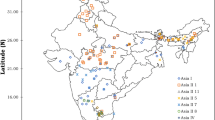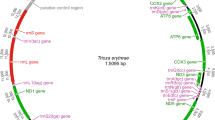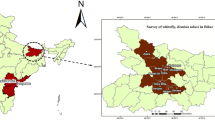Abstract
Phylogenetic analysis using ITS1 and CO1 nucleotide sequences has revealed six major races ofBemisia tabaci in the world, including three major indigenous races in the Asia-Pacific region,viz., B. tabaci (Asia),B. tabaci (Bali) andB. tabaci (Australia), but the status of a large collection of genotypes in this region remains unresolved. The ITS1 sequences of representative whitefly samples collected from around China were determined in this study. These sequences and other homologous sequences retrieved from GenBank were then used to conduct a phylogenetic analysis. The results demonstrated that the whiteflies collected in China were split genetically into four groups, where at least five genetic races were revealed,i.e., B biotype (SDLe, XJEp, XJAt, HNNt, BJIb, GDEp, XJGh, GDHrs, XJSm and SHEp), Bali group (ZJGh), M biotype (Hainan1), G biotype (GXCm) and Asian H/K group (FJIb, GDCv), although the Asian H/K group with low bootstrap score remains unresolved. Of all genetic races, the B biotype is the most extensively distributed. In the dendogram, the J biotype, L biotype and Q biotype cluster together and form a sister clade to the B biotype. The data indicate that extensive migration ofB. tabaci has taken place in Asian countries. The populations ZJGh, FJIb, GDCv, GXCm and Hainanl collected in China might have originated there, but the possibility that they were introduced from elsewhere cannot be excluded at this point. Using PyR from Israel as a reference Q biotype, the random amplified polymorphic DNA banding patterns of SDLe, XJEp, XJAt and HNNt were shown to be consistent with that of the Q biotype, which indicated that the four local whitefly populations identified as the B biotype based on ITS1 sequences were closely related to the Q biotype.
Similar content being viewed by others
References
Abdullahi, I., Winter, S., Atiri, G.I. and Thottappilly, G. (2003) Molecular characterization of whitefly,Bemisia tabaci (Hemiptera: Aleyrodidae) populations infesting cassava.Bull. Entomol. Res. 93:97–106.
Bedford, I.D., Markham, P.G., Brown, J.K. and Rosell, R.C. (1994) Geminivirus transmission and biological characterization ofBemisia tabaci (Gennadius) from different geographic regions.Ann. Appl. Biol. 125:311–325.
Bellows, T.S., Perring, T.M., Gill, R.J. and Headrick, D.H. (1994) Description of a species ofBemisia (Homoptera: Aleyrodidae) infesting North American agriculture.Ann. Entomol. Soc. Am. 87:195–206.
Brown, J.K. and Bird, J. (1995) Variability within theBemisia tabaci species complex and its relation to new epidemics caused by Geminivirus.Ceiba 36:73–80.
Byrne, F.J., Bedford, I.D., Devonshire, A.L. and Markham, P.G. (1995) Esterase variation and squash silverleaf induction in B-typeBemisia tabaci (Gennadius).Bull. Entomol. Res. 85:175–179.
Campbell, B.C. (1993) Congruent evolution between whiteflies (Homoptera: Alerodidae) and their bacterial endosymbionts based on respective 18S and 16S rDNAS.Curr. Microbiol. 26:129–132.
Campbell, B.C., Seffen-Campbell, J.D. and Gill, R.J. (1996) Origin and radiation of whiteflies: an initial molecular phylogenetic assessment.in: Gerling, D. and Mayer, R.T. [Eds.] Bemisia: 1995 Taxonomy, Biology, Damage, Control and Management. Intercept Ltd., Andover, Hants, UK. pp. 29–51.
Cervera, M.T., Cabezas, J.A., Simon, B., Martinez-Zapater, J.M., Beitia, F. and Cenis, J.L. (2000) Genetic relationships among biotypes ofBemisia tabaci (Hemiptera: Aleyrodidae) based on AFLP analysis.Bull. Entomol. Res. 90:391–396.
Claridge, M.F., Dawah, H.A. and Wilson, M.R. (1997) Species in insect herbivores and parasitoids — sibling species, host races and biotypes.in: Claridge, M.F., Dawah, H.A. and Wilson, M.R. [Eds.] Species, the Units of Biodiversity. Chapman & Hall, London, UK. pp. 247–272.
Costa, H.S. and Brown, J.K. (1991) Variation in biological characteristics and esterase patterns among populations ofBemisia tabaci, and the association of one population with silverleaf symptom induction.Entomol. Exp. Appl. 61:211–219.
De Barro, P.J. (2005) Genetic structure of the whiteflyBemisia tabaci in the Asia-Pacific region revealed using microsatellite markers.Mol. Ecol. 14:3695–3718.
De Barro, P.J. and Driver, F. (1997) Use of RAPD-PCR to distinguish the B biotype from other biotypes ofBemisia tabaci (Gennadius) (Hemiptera: Aleyrodidae).Aust. J. Entomol. 36:149–152.
De Barro, P.J., Driver, F., Trueman, J.H. and Curran, J. (2000) Phylogenetic relationships of world populations ofBemisia tabaci (Gennadius) using ribosomal ITS1.Mol. Phylogenet. Evol. 16:29–36.
De Barro, P.J., Liebregts, W. and Carver, M. (1998) The distribution and identity of biotypes ofBemisia tabaci (Gennadius) (Hemiptera: Aleyrodidae) in member countries of the Secretariat of the Pacific Community.Aust. J. Entomol. 37:214–218.
De Barro, P.J., Scott, K.D., Graham, G.C., Lange, C.L. and Schutze, M.K. (2003) Isolation and characterisation of microsatellite loci inBemisia tabaci.Mol. Ecol. Notes 3:40–43.
De Barro, P.J., Trueman, J.W.H. and Frohlich, D.R. (2005)Bemisia argentifolii is a race ofB. tabaci: the molecular genetic differentiation ofB. tabaci populations around the world.Bull. Entomol. Res. 95:193–203.
Felsenstein, J. (1993) PHYLIP (Phylogeny Inference Package) version 3.5c. Distributed by the author. Dept. of Genetics, University of Washington, Seattle, WA, USA.
Frohlich, D.R., Torres-Jerez, I.I., Bedford, D., Markham, P.G. and Brown, J.K. (1999) A phylogeographical analysis of theBemisia tabaci species complex based on mitochondrial DNA markers.Mol. Ecol. 8:1683–1691.
Gawell, N.J. and Bartlett, A.C. (1993) Characterization of differences between whiteflies using RAPD-PCR.Insect Mol. Biol. 2:33–38.
Guindon, S. and Gascuel, O. (2003) A simple, fast and accurate method to estimate large phylogenies by maximum-likelihood.Syst. Biol. 52:696–704.
Higgins, D., Thompson, J., Gibson, T., Thompson, J.D., Higgins, D.G. and Gibson, T.J. (1994) CLUSTAL W: improving the sensitivity of progressive multiple sequence alignment through sequence weighting, position-specific gap penalties and weight matrix choice.Nucleic Acids Res. 22:4673–4680.
Horowitz, A.R., Denholm, I., Gorman, K., Cenis, J.L., Kontsedalov, S. and Ishaaya, I. (2003) Biotype Q ofBemisia tabaci identified in Israel.Phytoparasitica 31:94–98.
Kimura, M. (1980) A simple method for estimating evolutionary rate of base substitutions through comparative studies of nucleotide sequences.J. Mol. Evol. 16:111–120.
Kumar, S., Tamura, K., Jakobsen, I.B. and Nei, M. (2001) MEGA2: Molecular Evolutionary Genetics Analysis Software. Arizona State University, Tempe, AZ, USA.
Li, Z.X., Hu, D.X., Song, Y. and Shen, Z.R. (2005) Molecular differentiation of B biotype from other biotypes ofBemisia tabaci (Homoptera: Aleyrodidae) based on internally transcribed spacer 1 sequence.Eur. J. Entomol. 102:293–297.
Lin, L. and Ren, S.X. (2005) The effects of host plantCodiaeum variegatum on the development and reproduction of B biotype ofBemisia tabaci.J. S. China Agric. Univ. 26:39–42.
Luo, C., Yao, Y., Wang, R.J., Yan, F.M., Hu, D.X. and Zhang, Z.L. (2002) The use of mitochondrial cytochrome oxidase (mtCOI) gene sequences for the identification of biotypes ofBemisia tabaci (Gennadius) in China.Acta Entomol. Sin. 45:759–763.
Muniz, M. (2000) Host suitability of two biotypes ofBemisia tabaci on some common weeds.Entomol. Exp. Appl. 95:63–70.
Nei, M. and Kumar, S. (2000) Molecular Evolution and Phylogenetics. Oxford University Press, New York, NY.
Oliveira, M.V., Henneberry, T.J. and Anderson, P. (2001) History, current status, and collaborative research projects forBemisia tabaci.Crop Prot. 20:709–723.
Perring, T.M. (2001) TheBemisia tabaci species complex.Crop Prot. 20:725–737.
Perring, T.M., Cooper, A.D., Rodriguez, R.J., Farrar, C.A. and Bellows, T.S. (1993) Identification of a whitefly species by genomic and behavioral studies.Science 259:74–77.
Tsagkarakou, A. and Roditakis, N. (2003) Isolation and characterization of microsatellite loci inBemisia tabaci (Hemiptera: Aleyrodidae).Mol. Ecol. Notes 3:196–198.
Zhang, L.P., Zhang, Y.J., Zhang, W.J., Wu, Q.J., Xu, B.Y. and Chu, D. (2005) Analysis of genetic diversity among different geographical populations and determination of biotypes ofBemisia tabaci in China.J. Appl. Entomol. 129:121–128.
Zhou, Y. (1949) A checklist of whitefly in China.Chin. J. Entomol. 3:1–18.
Author information
Authors and Affiliations
Corresponding author
Additional information
http//www.phytoparasitica.org posting Sept. 12, 2006.
Rights and permissions
About this article
Cite this article
Li, ZX. Molecular phylogenetic analysis reveals at least five genetic races ofBemisia tabaci in China. Phytoparasitica 34, 431–440 (2006). https://doi.org/10.1007/BF02981197
Received:
Accepted:
Issue Date:
DOI: https://doi.org/10.1007/BF02981197




